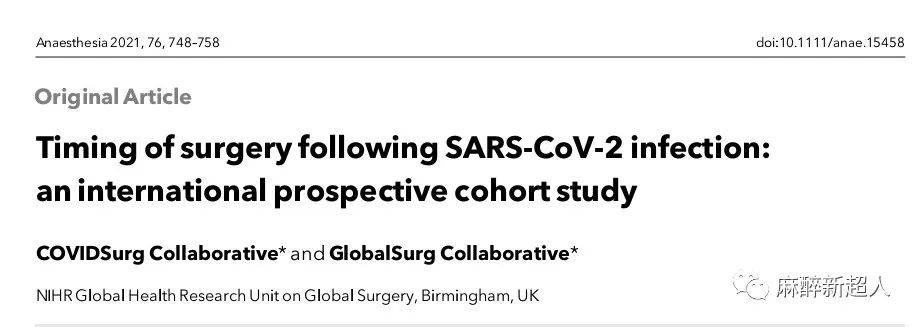
作者:米勒之声
Timing of surgery followingSARS-CoV-2 infection: an international prospective cohort study
SARS-CoV-2感染后手术时机:一项国际前瞻性队列研究
NIHRGlobalHealthResearchUnitonGlobalSurgery, Birmingham, UK
国家卫生研究院全球外科研究小组,伯明翰,英国
Summary
Peri-operative SARS-CoV-2 infection increases postoperative mortality. The aimofthisstudywastodetermine theoptimaldurationofplanneddelaybeforesurgeryinpatientswhohavehadSARS-CoV-2 infection. This international, multicentre, prospectivecohortstudy included patients undergoingelectiveoremergency surgery during October 2020. Surgical patients with pre-operative SARS-CoV-2 infectionwerecomparedwith thosewithout previous SARS-CoV-2 infection. The primary outcome measure was 30-day postoperative mortality. Logisticregressionmodelswereusedtocalculate adjusted 30-day mortality rates stratified by time fromdiagnosisofSARS-CoV-2 infectiontosurgery. Among140,231 patients (116 countries), 3127 patients (2.2%) had a pre-operative SARS-CoV-2 diagnosis. Adjusted 30-day mortality in patientswithoutSARS-CoV-2 infectionwas 1.5% (95%CI 1.4– 1.5). Inpatientswithapre-operativeSARS-CoV-2 diagnosis, mortalitywas increasedinpatientshavingsurgerywithin 0–2 weeks, 3–4 weeksand 5–6 weeksof the diagnosis (odds ratio (95%CI) 4. 1 (3.3–4.8), 3.9 (2.6–5. 1) and 3.6 (2.0–5.2), respectively). Surgery performed ≥ 7 weeks after SARS- CoV-2 diagnosis was associated with a similar mortality risk to baseline (odds ratio (95%CI) 1.5 (0.9–2. 1)). After a ≥ 7 weekdelayinundertakingsurgeryfollowingSARS-CoV-2 infection, patients with ongoing symptoms had a highermortalitythanpatientswhose symptoms had resolved or who had been asymptomatic (6.0% (95%CI 3.2– 8.7) vs. 2.4% (95%CI 1.4–3.4) vs. 1.3% (95%CI 0.6–2.0), respectively). Wherepossible, surgeryshouldbedelayedfor at least 7 weeks following SARS-CoV-2 infection. Patients with ongoing symptoms ≥ 7 weeks from diagnosis may beneitfromfurtherdelay.
摘要
围手术期SARS-CoV-2感染增加了术后死亡率。这项研究的目的是确定SARS-CoV-2感染患者术前计划延迟手术的最佳时间。这项国际性、多中心、前瞻性队列研究纳入了2020年10月接受择期或急诊手术的患者,将术前感染SARS-CoV-2的手术患者与术前未感染SARS-CoV-2的手术患者进行比较。主要观察指标为术后30天内患者死亡率。采用Logistic回归模型计算从SARS-CoV-2感染诊断到手术时间的调整后30天死亡率。在140231例患者(116个国家)中,3127例患者(2.2%)术前诊断为SARS-CoV-2。未感染SARS-CoV-2的患者调整手术时间后30天死亡率为1.5% (95%CI 1.4-1.5)。在术前诊断为SARS-CoV-2的患者中,在诊断后0-2周、3-4周和5-6周内手术的患者死亡率增加(优势比(95%CI)分别为4.1(3.3-4.8)、3.9(2.6-5.1)和3.6(2.0-5.2))。SARSCoV-2诊断后≥7周进行手术与基线死亡风险相似(优势比(95%CI) 1.5(0.9-2.1))。在SARS-CoV-2感染后延迟手术≥7周后,持续症状患者的死亡率高于症状缓解或无症状患者(分别为6.0% (95%CI 3.2 - 8.7) vs. 2.4% (95%CI 1.4-3.4) vs. 1.3% (95%CI 0.6-2.0))。在可能的情况下,手术应在SARS-CoV-2感染后至少推迟7周。手术时间的进一步推迟可能会使诊断后症状持续≥7周的患者受益。
